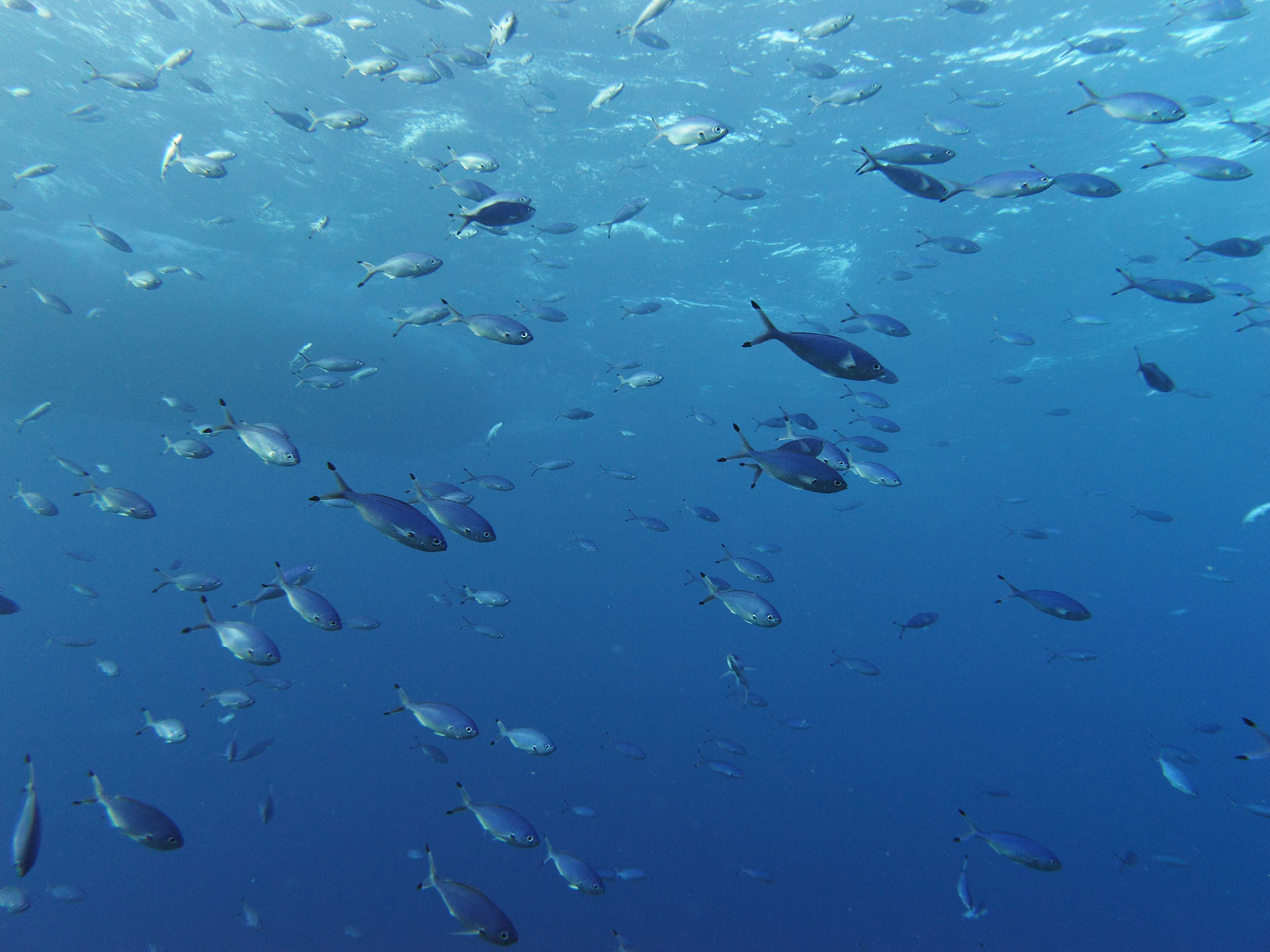Feature image by Alexander Vasenin CC BY-SA 3.0, via Wikimedia Commons
Two weeks ago, the dawn setting of the Well Bucket heralded the onset of the heavy marking rains of autumn. This began the new year in both of the calendars we are following. This week, the rain star calendar has no activity, but the calendar of lunar stations continues with an asterism that dates to Babylonian times (1st-2nd millennia BCE).
If you’ve read the Well Bucket post in this Arab star calendar blog, you know that a Well Rope (al-risha’) connects to the Well Bucket. The bright star that marks the Well Rope also represents the belly or heart of the Great Fish (al-hut or as-samaka al-‘azima), one of several that roam the starry seas.
حتى إذا ما الحوت في حوض من الدلو كرع
…until the time when the Great Fish
put its mouth into a watering trough
by the Well Bucket and drank… Muhammad bin Yazid al-Husna,
7th/8th century C.E.
The preceding line of poetry connects the Great Fish (al-hut) with the celestial complex of the Well Bucket. Many ancient wells had watering troughs built next to them in order to collect the drawn water for the herded animals like camels, sheep or goats. In the calendar of the lunar stations, the setting of the Great Fish marked the time when the water levels in the wells stopped sinking. The ongoing heavy rains of autumn replenished water in the well and added fresh water to the trough, so there was plenty to drink. The Great Fish lies right next to the Well Bucket, so perhaps it too is getting refreshed with the collected waters of autumn.
How to observe the Great Fish
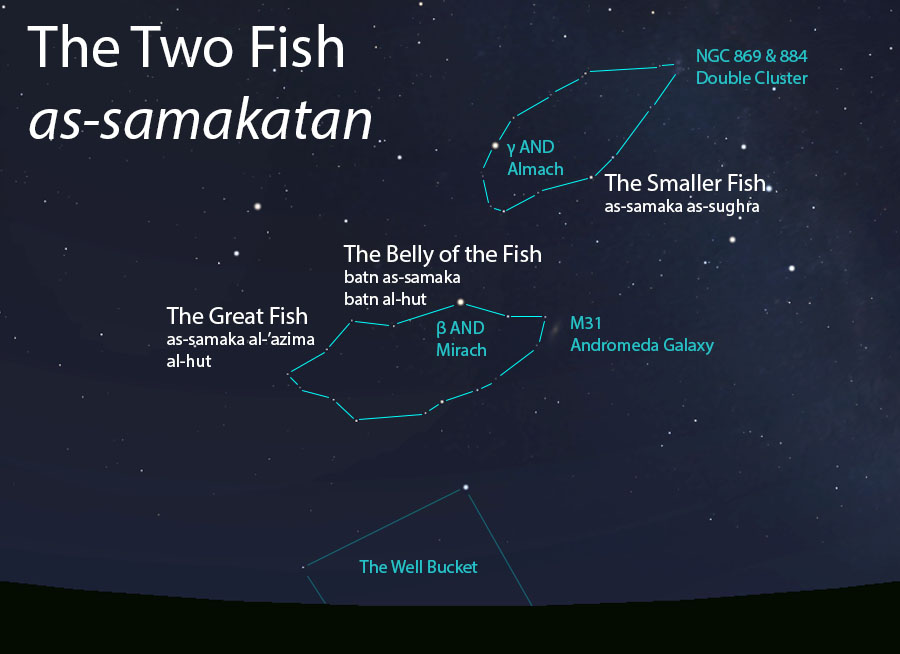
The Great Fish (al-hut or as-samaka al-‘azima) and the Smaller Fish (as-samaka as-sughra) as they appear in the west about 45 minutes before sunrise in mid-October. Sky simulations made with Stellarium.
The proper time to observe a star’s morning setting (or rising) is called ghalas in Arabic, at time when the darkness of night mixes with the white and red light of dawn in the tracts of the horizon (How to Observe). As with the Well Bucket, the one bright star of the Great Fish will start to disappear 45-30 minutes before your local sunrise (times available at timeanddate.com). However, the fainter stars of the Great Fish will require you to be ready to observe about 75 minutes before sunrise. This week, there is no moon in the morning, so these faint stars should be visible unless you are observing from a location with heavy light pollution.
To spot the Great Fish, look to the western horizon. There, you will see one or two of the four Well Bucket stars from my last post. The primary star of the Great Fish lies above the uppermost Crossbar star, but some distance from it. Observing from Tucson this week, only the uppermost star of the Well Bucket was visible at 45 minutes before sunrise, so do be sure to allow yourself enough time to find your Well Bucket landmarks before they sink below the horizon.
The Belly of the Great Fish as a lunar station
For a brief description of the lunar stations, please see the Celestial Complexes section on the About page.
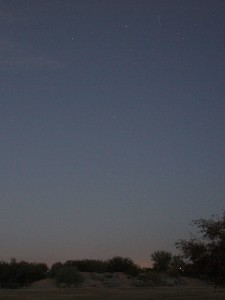
The Great Fish as observed from Tucson, Arizona, at 5:45am (45minutes before sunrise) on Oct 15, 2015. The first bright star above the trees is the last star of the Well Bucket.
The bright star that we have just located is the Belly of the Fish (batn al-hut or batn as-samaka). It was also called the Heart of the Fish (qalb al-hut), likely on account of its red-orange color. Sometimes it is simply called al-hut, so al-hut can refer to either the whole asterism of the Great Fish or just the single bright star that represents its Belly or Heart. We’ll see this pattern with other star names, too.
The Belly of the Fish is the only part of the Great Fish that is visible through the growing light of dawn. Therefore, the Belly is the part of the asterism that is most able to function as part of a morning star calendar. Within the celestial complex of the lunar stations, the Great Fish (and its Belly) is always mentioned using the terms al-hut or batn al-hut and never as-samaka al-‘azima or batn as-samaka. In the account of Qutrub (died 821 CE), the Great Fish is listed as the second lunar station, but Ibn Qutayba (died 889) and those following him list it as the 28th and final lunar station. (For more details on the reasons for this change, see my previous blog post.) Later authors tend to list batn al-hut specifically as the lunar station, perhaps because by that time the name al-hut had been transferred to a Greek constellation (see “Three Greek fish” below).
The Great Babylonian Fish
Material in this post regarding Mesopotamian astronomy comes from a two-part article by John H. Rogers entitled “Origins of the ancient constellations” and published in the Journal of the British Astronomical Association, Volume 108 (1998), Issues 1 and 2.
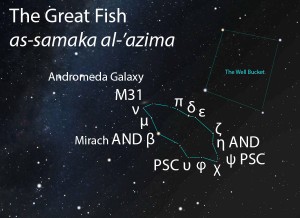
The Great Fish (as-samaka al-‘azima) as it appears in the east under dark skies about 1 hour after sunset in mid-October.
It is not known when the Fish came to be recognized in Babylon. We do know that its presence in the sky helped shape the zodiacal constellation that we know today as Pisces, whose two fish were originally much larger than the Greeks drew them. Babylonian star calendars for farming typically focused on the rising of stars before dawn, rather than their setting. The rising orientation provides an upright view of the Great Fish, so I will present the asterism as you will see it rising in the east during the evening hours this week.
Starting at the Belly of the Fish, which is part of the underside of the Fish, follow a line of two more stars up and to the left a bit until you see a small fuzzy cloud in the sky. Today, we know this cloud to be an entire galaxy that we call the Andromeda Galaxy (M31). It is much like our own Milky Way but almost twice as large. This fuzzy patch in the sky marks the mouth of the Great Fish.
From the Andromeda Galaxy, now follow a chain of stars to the right and slowly curving downward. A row of three stars that lie between the Belly of the Fish and the Well Bucket will be the brighter ones in this chain. Continue through them downward until the chain curves to the left and starts heading back up the sky toward the Belly of the Fish. You will need a relatively dark sky to trace the full outline.

The Andromeda Galaxy (at the mouth of the Great Fish) as captured by the Hubble Space Telescope.
NASA, ESA, J. Dalcanton, B. F. Williams, L. C. Johnson (U. Washington), PHAT team, R. Gendler
The Smaller Fish

The Smaller Fish (as-samaka as-sughra) as it appears in the east under dark skies about 1 hour after sunset in mid-October.
The Smaller Fish was mentioned in Arabic writings of the 9th century CE, but unlike the Great Fish, it does not appear to be of Babylonian origin. However, like the Great Fish, the Smaller Fish has a bright star in the location of its belly, but in this case it is not named as such in the literature. If you trace a curved line from the Well Bucket through the Belly of the (Great) Fish to an equal distance beyond it, you will arrive at a bright star that is in the position of the belly of the Smaller Fish. From this star, trace a chain of stars that first goes toward the Belly of the (Great) Fish and then curves to the left in the sky. This chain ends at another fuzzy patch in the sky that happens to be two dense star clusters located very close to each other, the Double Cluster of the modern constellation Perseus. This cloudy patch represents the tail of the Smaller Fish. From here, follow a trail of fainter stars back down to the “belly” of the Smaller Fish. Thus, as you look at the sky this evening, the Smaller Fish faces right, and the Great Fish faces left.
Three Greek fish
In order to understand what happened to our Two Fish in the sky once Greek astronomy was translated into Arabic, we first need to go back to ancient Mesopotamia. During the early 3rd millennium BCE, the civilization of Sumer regarded the modern Greek constellation of Aquarius as a representation of their god Ea, who poured two streams of water from a pitcher. (Sound familiar?)
One of Ea’s streams went southward to a bright star that has represented a fish since Sumerian times. This star, together with an oblong circle of stars around it, were adopted by the Greeks two millennia later as the constellation Pisces Austrinus, the Southern Fish. This fish was translated into Arabic directly as the Southern Great Fish (al-hut al-janubi). The bright star that has marked this constellation for 5000 years is known to us today as Fomalhaut, which is a Latinized transliteration of fam al-hut, “the Mouth of the Fish.”
The other Mesopotamian stream that was poured from Ea’s pitcher went eastward among the stars, in the direction of the Arab Great Fish. As mentioned above, we don’t know when this Great Fish first graced the skies of Mesopotamia. However, at some point later, this asterism was joined to another asterism that had been regarded by the Babylonians as a Swallow. Joined by two long cords tied together, they became the Babylonian zodiacal constellation of the Two Fish, but this was not quite Pisces as the Greeks drew it.
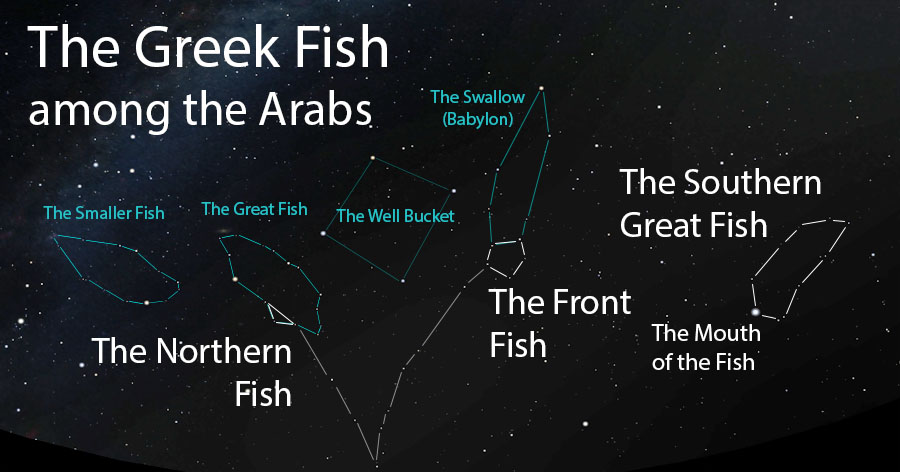
The Greek fish among the Arabs, as they appear in the west and south about an hour after sunset in mid-October.
In creating Pisces, the Greeks reduced the size of both the Great Fish (known by the Babylonians as the Northern Fish) and the Western Fish (formerly the Swallow) to make room for the Greek constellations of Andromeda and Pegasus, respectively. These two fish of Pisces were translated into Arabic as the Northern Fish (as-samaka ash-shamaliya) and the Front Fish, respectively (as-samaka al-mutaqadima). Although the constellation as a whole was referred to literally as the Two Fish (as-samakatan), it also was known as al-hut. Once again, the name for an existing pre-Greek asterism was repurposed for an adopted Greek constellation, and the original asterism disappeared from public awareness.
Now, when you look up at the constellation Andromeda, remember that long ago much of that constellation was caught up in a giant fish tale that lasted for thousands of years.
What’s next?
Next time, we’ll look at the asterism that forever changed the Arab calendars.
In the meantime, I’d love to hear from you! On which day did the Belly of the Fish set for you in the galas of the morning? Were you able to make out the outline of the Great Fish? How about the Smaller Fish?
Please leave a comment below, and be sure to include your city and state/country so we can see how the setting times vary by location.
Star Catalog Entries for this Celestial Complex
The Two Fish Complex (as-samakatan, السمكتان)
The Great Fish (al-hut, الحوت) and its Belly (batn al-hut, بطن الحوت)
The Great Fish (as-samaka al-‘azima, السمكة العظيمة) and its Belly (batn as-samaka, بطن السمكة)
The Smaller Fish (as-samaka as-sughra, السمكة الصغرى)
Click here to go to the full star catalog (a work in progress).

